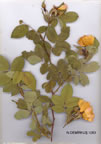| Rosaceae |
 Rosa canina. |
| Rosa L. Rosa canina L. Ömür: Çok yıllık Yapı: çalı Hayat formu: İlk çiçeklenme zamanı: 5 Son çiçeklenme zamanı: 7 Habitat: kıyılar, kayalık yamaçlar, çalılık, çitler, ormanlar ve açıklıkları, başlıca kireçtaşları Minimum yükseklik: 30 Maksimum yükseklik: 1700 Endemik: - Element: ? Türkiye dağılımı: Türkiye Genel dağılımı: Ilıman Avrasya, KB. Afrika Bulunduğu kareler :A1 A2 A3 A4 A5 A6 A7 A8 A9 B1 B2 B3 B4 B5 B6 B7 B8 B9 B10 C2 C3 C4 C5 C6 C8 C9 C10 |
| R. canina L., Sp. P1. 491 (1753). Syn: R. collina Jacq., Fl. Austr. 2:58 (1774)! R. caucasica Pallas, Fl. Ross. 1(2):62 (1788); R. corymbifera Borkh., Vers. Forstbot. Beschr. Holzart. 319 (1790); R. dumetorum Thuill., Fl. Par. ed. 2:250 (1798-1799); R. klukii Besser, Cat. Fl. Horto Cremen. 118 (1816); R. urbica Léman in Bull. Soc. Philom. Paris 93 (1818); R. lutetiana Léman, op. cit. 93 (1818), R. deseglisei Bor., Fl. Centr. Fr. ed. 3: 224 (1857); R. tomentella Leman var. acuta (Crépin) Christ in Boiss., Fl. Or. Suppl. 217 (1888). Ic: Fiori, Ic. Fl. Ital. f. 1799 (1899). Erect shrub, (0.5-)l.5-3.5(-7) m, sometimes climbing; branches often curved or arched. Prickles rather coarse, ± curved, compressed with a dilated base, ± uniform, occasionally lacking. Leaves dull to pure green; leaflets 5-7, narrowly elliptic to broadly ovate, 1-4.5 x 0.8-3.5 cm, obtuse to acute with a rounded to cuneate base, glabrous to pubescent, at least beneath, sometimes with some glands on the nerves beneath, uni- or bi-serrate, occasionally glandular-biserrate, teeth distinct, usually long and acute, 17-20 on each side; stipules narrow to broad, usually with long straight auricles. Flowers solitary or 2-15 together, bracts often broad. Pedicels l-2.5(-4.5) cm, smooth or glandular-hispid. Sepals ovate, often with a rather short apically dilated tip, outer sepals pinnatifid with narrowly to broadly lanceolate, entire or glandular-toothed lobes, glabrous, pubescent or occasionally with glands on the back, usually reflexed and deciduous soon after anthesis. Petals up to 3 cm, white to pale pink, rarely deep pink. Styles often long, exserted, usually glabrous to sparsely hairy, occasionally villous, stigma-head ± loose, globose to conoidal; disc broad, conoidal, orifice narrow. Hypanthia ovoid to globose, l-2.5(-3) cm, yellowish red to pure red, ripening late. Fl. 5-7. Banks, rocky slopes, scrub, hedges, forests and clearings, mainly on limestone, 30-1700(-2500) m. Described from Europe (Hb. Linn. 652/31, photo!). A very polymorphic species. No attempts have been made to produce a formal infraspecific classification since the 'groups' that can be delimited depend entirely on the characters chosen and transitions are frequent whatever the grouping. With regard to indumentum of the leaves and of the pedicels, at least four main form-series may be distinguished in Turkish material (if characters from the prickles, leaf serration, sepals, petals and styles are added the number of forms is much increased). These form series may be characterized as follows: (a) leaflets glabrous, pedicels smooth; (b) leaflets glabrous, pedicels glandular-hispid; (c) leaflets pubescent, at least beneath, pedicels smooth; (d) leaflets pubescent, pedicels glandular-hispid. These forms have similar distributions in Turkey but the first two are mainly lowland plants while the other two occur at higher elevations as well. The appropriate letter in brackets follows the citations where the form-series is known. A1(E) Tekirdağ: Tekirdağ, T. Baytop 12702 (c)! A1(A) Çanakkale: 25 km N. of Gelibolu, 10 m, Sorger 68-2-78 (c)! A2(E) Istanbul: Belgrade Forest, Gözler(ISTE 12634) (c)! A2(A) Kocaeli: Hereke, 100 m, D. 42015 (a)! A3 Bolu: Abant G., 1400 m, Sorger 69-4-102 (d)! A4 Kastamonu: above Kastamonu, 1100 m, D. 21769 (a)! A5 Çorum: Hacılar hani, Sungurlu, Tanker (ISTE 4484) (d)! A6 Ordu: Ünye to Fatsa, nr. s.l., A. & T. Baytop 15265 (b)! A7 Trabzon: nr. Akçabat, A. & T. Baytop 15282 (d)! A8 Çoruh: d. Yusufeli, Serigöl to Barhal, 900-950 m, D. 47667 (a)! A9 Kars: c. 50 km S. of Kars, 1540 m, M. Zohary & Plitm. 2267-39 (c)! B1 Balikesir: Edremit, 22 v 1963, Regel (c)! B2 Kütahya: Murat Da., above Kesik Söğüt, 1650 m, D. 36764 (c)! B3 Afyon: Afyonkarahisar, A. Baytop 9370. (c)! B4 Ankara: nr. Ankara, Borum. 1892:3158 (a)! B5 Yozgat: 32 km from Sorgun to Çekerik, 1200 m, Coode & Jones 1626 (c)! B6 Sivas: Karacayır, 8 km N. of Sivas, 1350 m, Sorger 70-19-44 (//)! B7 Elazığ: Maden, 1300 m, D. 28889 (t/)! B8 Bitlis: halfway from Baykan to Bitlis, 1250 m, D. 43162 (c)! B9 Bitlis: Tatvan to Tug, 1800 m, D. 22339 (c)! B10 Ağri: Ağri Da. (Grossheim 5: map 148). C2 Antalya: Akdağ, c. 1500 m, Sorger 67-22-5 (c)! C3 Isparta: Kuru Tepe, Sorger 67-4-47 (c)! C4 Konya: Ermenek, 1000 m, D. 16205 (c)! C5 Niğde: Ala Da., Emli Gorge, 2000 m, Parry 228 (c)! C6 Maraş: Maraş, 800 m, .D. 27468 (c)! C8 Mardin: 10 km from Gerçuş to Hasankeyf, 700-800 m, D. 43013 (c)! C9 Hakkari: Zap Gorge, 1600 m, D. 23911 (a)! C10 Hakkari: 40 km from Yüksekova to Şemdinli, 1600 m, D. 45091 (d)! Is: Lesvos, Cami.; Khios, Orphanides 3735. Distribution of species: temperate Eurasia, N.W. Africa. Part of the variation of R. canina is probably due to hybridization with other species. The following specimen is probably a hybrid: R. canina x R. pimpinellifolia-A8 Gümüşane: Haldizan Da., N. of Bayburt, 2750 m, Balls 1852! The remainder of the putative hybrids, with more or less certain parentage, involving R. canina as one parent, are cited under the other parent. |